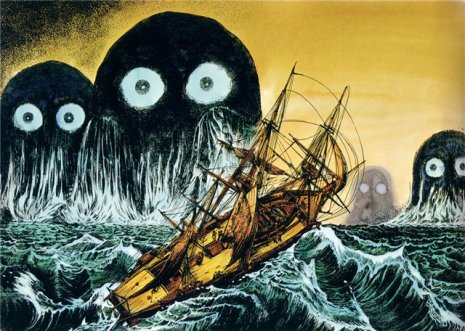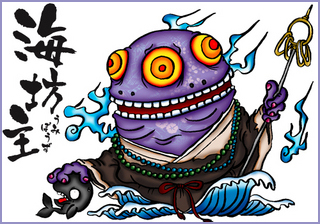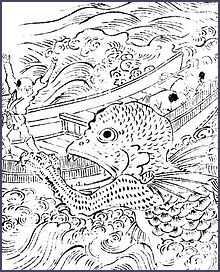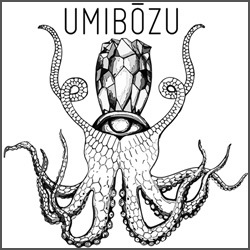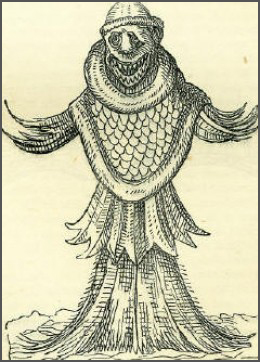. Ubagami 姥神 "Old Woman Deity" .
:::::::::::::::::::::::::::::::::::::::::::::::::::::::::::::::::::::::::::::::::::::::::::::::::::::::::::::::::::::::::::::::::::::::::::::::::::::::::::::::::::::::::::::::::::
Yamanba, Yamauba 山姥 and 山姫 Yamahime
Yamanba, Yamamba is the "old hag from the mountain"
Yamahime is "princess of the mountain", a Yokai monster, also called
Yama onna 山女 "woman of the mountain".
- quote
山姫(やまひめ)または山女(やまおんな)は、日本に伝わる妖怪。その名の通り、山奥に住む女の姿をした妖怪である。
各伝承により性質に差異はあるものの、多くは長い髪を持つ色白の美女とされる。服装は半裸の腰に草の葉の蓑を纏っているともいうが、樹皮を編んだ服を着ている、十二単を着た姿との説もある.
The wikipedia features some legends about the Yamahime.
- source : wikipedia
.......................................................
- quote -
Yamauba (山姥 or 山うば), Yamamba or Yamanba are variations on the name of a yōkai found in Japanese folklore.
- - - Description
Depending on the text and translator, the Yamauba appears as a monstrous crone, “her unkempt hair long and golden white ... her kimono filthy and tattered,” with cannibalistic tendencies. In one tale a mother traveling to her village is forced to give birth in a mountain hut assisted by a seemingly kind old woman, only to discover, when it is too late, that the stranger is actually Yamauba, with plans to eat the helpless Kintarō. [5] In another story the yōkai raises the orphan hero Kintarō, who goes on to become the famous warrior Sakata no Kintoki.
Yamauba
is said to have a mouth at the top of her head, hidden under her hair. In one story it is related that her only weakness is a certain flower containing her soul.

Yamauba, Hair Undone, by Hokusai
- - - Noh Drama
In one Noh drama, translated as, Yama-uba, Dame of the Mountain, Komparu Zenchiku states the following:
Yamauba is the fairy of the mountains, which have been under her care since the world began. She decks them with snow in winter, with blossoms in spring ... She has grown very old. Wild white hair hangs down her shoulders; her face is very thin. There was a courtesan of the Capital who made a dance representing the wanderings of Yamauba. It had such success that people called this courtesan Yamauba though her real name was Hyakuma.
The play takes place one evening as Hyakuma is traveling to visit the Zenko Temple in Shinano, when she accepts the hospitality of a woman who turns out to be none other than the real Yamauba, herself.
- - - More in the WIKIPEDIA !
.......................................................................................
source : www.garitto.com
. Ogawa Usen (1868-1938) .
..............................................................................................................................................

yamanba 山姥(やまんば)old mountain woman, who breastfeeds a baby.
This is said to be a symbol of Mother Mary feeding the baby Christ.
Nagasaki, Amakusa 天草土人形 Amakusa clay doll
. Amakusa tsuchi ningyoo 天草土人形 Amakusa Clay Dolls .
:::::::::::::::::::::::::::::::::::::::::::::::::::::::::::::::::::::::::::::::::::::::::::::::::::::::::::::::::::::::::::::::::::::::::::::::::::::::::::::::::::::::::::::::::::
- quote -
komochi yamanba 嫗山姥 "The Pregnant Mountain Ogres"
This work depicts one of the scenes of "The Pregnant Mountain Ogres (Komochi Yamanba)", which was created by Chikamatsu Monzaemon and performed at the show with an all-star cast at the Ichimuraza theater in 1812.
- source : library.metro.tokyo.lg.jp .. -
- quote -
Komochi Yamanba / Yaegiri Kuruwa Banashi
The puppet play "Komochi Yamanba" was premiered in the 7th lunar month of 1712 in Ôsaka at the Takemotoza. It was adapted for Kabuki more than 8 decades later, in the 3rd lunar month of 1795 in Ôsaka at the Kado no Shibai [more details]. It was staged for the first time in Edo in the 9th lunar month of 1810 at the Nakamuraza.
"Komochi Yamanba" was originally made up of 5 acts. The most famous act, the second one, is still part of the current Kabuki reportoire. It is commonly called "Yaegiri Kuruwa Banashi" or "Shaberi".
- source : kabuki21.com/yaegiri_kuruwa... -
“Yamamba”. Edited by Rebecca Copeland and Linda C. Ehrlich.
:::::::::::::::::::::::::::::::::::::::::::::::::::::::::::::::::::::::::::::::::::::::::::::::::::::::::::::::::::::::::::::::::::::::::::::::::::::::::::::::::::::::::::::::::::
. Legends and Tales from Japan 伝説 - Introduction .
............................................................................ Aichi 愛知県
.......................................................................
犬山市 Inuyama city
. The wife of 与八郎 Yohachiro at 新蔵 Shinzo .
............................................................................ Fukushima 福島県
In the deep river water there live the Kappa who pull the children's chinchin (penis).
In the deep mountains there lives the Old Woman of the Mountain, Yamanba 山姥.
So you should never go to the river alone or go to the mountains alone.
In the mountains also wear a bell (as usually done to protect against bears.)
.......................................................................
. The Monster Woman from Kurozuka 黒塚 鬼ばば / 鬼女 Onibaba .
............................................................................ Gifu 岐阜県
池田町 Ikeda
yamanba 山姥 old woman in a mountain
山姥の危急を救ってやった男がいた。染物屋が紋付の着物を男のところにもってきたが覚えが無い。家紋に間違いが無いので受け取ったが、後日なくなっていた。山姥が持ち去ったのだといわれた。
.......................................................................
Gifu 各務原市 Kakamigahara city
. A wicked Ryujo 龍女 female dragon .
............................................................................ Iwate 岩手県
. Yamanba and the Okeya 桶屋 bucket maker .
- - - - -
In the region of 遠野 Tono
the Yama-onna has a great sexual appetite. She captures human men and enjoys sex with them as long as they last. Then she kills and eats them.
............................................................................ Kagoshima 鹿児島県
鹿児島県肝属郡牛根村(現・垂水市)では山奥に押し入ってきた男を襲い、生き血を啜るという[2]。信州(長野県)の九頭龍山の本性を確かめるために山中に入った男が、山姫に遭って毒気を浴びせられ、命を落としたという逸話もある。
屋久島では山姫をニイヨメジョとも呼び、伝承が数多く残る。十二単姿で緋の袴を穿いているとも、縦縞の着物を着ているとも、半裸でシダの葉で作った腰蓑を纏っているともいうが、いずれも踵に届くほど長い髪の若い女であることは共通している。山姫に笑いかけられ、思わず笑って返せば血を吸われて殺されるという。山姫をにらみつけるか、草鞋の鼻緒を切って唾を吐きかけたものを投げつけるか、サカキの枝を振れば難を逃れられる。しかし、山姫が笑う前に笑えば身を守れるとの伝承もある[6]。
かつて屋久島吉田集落の者が、山に麦の初穂を供えるため、旧暦8月のある日に18人で連れ立って御岳に登った。途中で日が暮れたため、山小屋に泊まった。翌朝の早朝、飯炊きが皆より早く起きて朝食の準備をしていたところ、妙な女が現れ、眠る一同の上にまたがって何かしている。結局、物陰に隠れていた飯炊き以外の全員が血を吸われて死んでいたという。
............................................................................ Kochi 高知県
In 大月町 Otsuki the Yama-onna is quite dangerous. She sucks blood out of humans and just seeing her from afar makes a person get high fever and die eventually.
............................................................................ Kumamoto 熊本県
熊本県下益城郡でいう山女は、地面につくほど長い髪に節を持ち、人を見ると大声で笑いかけるという。あるときに山女に出遭った女性が笑いかけられ、女性が大声を出すと山女は逃げ去ったが、笑われた際に血を吸われたらしく、間もなく死んでしまったという.
............................................................................ Miyagi 宮城県
1935年頃(昭和10年頃)、宮城県仙台市青葉区で山仕事に出た女性が3歳になる娘を草むらに寝かせて仕事をしていたところ、いつしか娘が姿を消していた。捜索の末、翌朝に隣り部落の山中で娘が発見され「母ちゃんと一緒に寝た」と答えていたことから、人々は山女か狐の仕業と語ったという。
.......................................................................
Miyagi 名取市 Natori city 下余田 Shimo-Yoda
nakani yashiki 中荷屋敷
経巻数百巻を馬に積み松島寺 Temple Matsushima に下る途中だった京の蘭駝という法師が、加賀の白山のふもとで1人の女に会う。女は、わしも奥州へ行くゆえ頼むといって小箱を託し、先に行って待つという。箱を馬の中荷にして下り、下余田で会うと、女は箱を受け取り礼をいい、白山姫神の化身だといって姿を消す。そこを中荷屋敷といって白山の祠がある。
.......................................................................
Miyagi 多賀城市 Tagajo City 南宮 Nangu
Nangu Jinja 南宮神社 Shrine Nangu Jinja
祭神の金山彦、金山姫に合祀されている和加佐姫命は、同市山王の日吉神社の祭神大山咋命に恋慕され、それを嫌って逃げ出した。麻畑で芋の葉にすべって茶の木で眼を痛めるなどして船形山に逃れ、臼を作っていた神主に頼んで臼の中に隠れ、その上に神主があぐらをかいたので山王の神も断念する。南宮の村ではそれ以来、麻と芋と茶は作らなくなり、山王の村では男が船形山へ登ると神罰があたるといって登らなくなる。
- There is also 南宮大社と南宮山 Nangu Taisha Shrine and Mt. Nangu
famous for being home to Kanayama-hiko, god of iron and the metals industry.
. source and more : nangu-taisha-shrine ... .
............................................................................ Miyazaki 宮崎県
.......................................................................
えびの市 Ebino town
The local Yamahime likes to wash her long hair and sing in a pleasant voice. But she also sucks the blood out of humans and they die.
.......................................................................
東臼杵郡 Higashiusuki
. Yama-Onna and the namekuji なめくじ slug .
.......................................................................
西米良村 Nishimera
The Yamahime from 烏帽子岳 Mount Eboshidake always lend bowls and trays (zenwan 膳椀) to people, but when handing them over she never showed her face and faced back. Once a young man tried to force her to show her face but from that day on, she stopped lending them.
. Zenwanbuchi 膳椀淵 "river pool for trays and bowls". .
............................................................................ Nagano 長野県
In 戸隠 the Togagushi region there is mount Kuzuryusan 九頭龍山 (Dragon with nine heads).
Once a village official wanted to see its real features and tried to climb the mountain. On the way he met Yamahime.
But she breathed her strong poison at him and he fell ill.
.......................................................................
Nagano 東筑摩郡 Higashi-Chikuma district 麻績村 Maji village
uba-ishi 姥石 Stone of the Old Woman
大山姫 Oyama Hime, the Grandmother of 木花咲耶姫 Konohana Sakura Hime climbed up
to 姥捨山 Ubasuteyama (冠着山 Kaumrikiyama).
She stayed there and became a stone.
............................................................................ Oita 大分県
At 黒岳 Mount Kurodake the Yamahime is quite a beautiful lady. Once a traveler who did not recognize her, began to talk to her. She stuck her tongue out longer and longer and sucked his blood until he was dead.
.......................................................................
東国東郡 Higashi-Kunisaki district 安岐町 Aki
Yamanba has killed and eaten the mother, put on her robes and then went to the home where her three children lived. There she ate the youngest child. The two others climbed a tree and askes Ten no Kami 天の神 The God of Heaven for help.
山姥が母親を食い殺し、着物を着て戻ってくる。3人の子が山姥を家に入れてしまう。末の子は食われ、残った2人は木に登り天の神に救いを求める。金の鎖が降りてきて、姉は月になり利口な妹はお天道様になった。山姥は昇ろうとして落ち、その血がススキの根についた。
............................................................................ Okayama 岡山県
During the end of the Meiji and beginning of Taisho period, there lived a Yamahime in the back mountains of Okayama. Her long hair hung down wild and her eyes glittered with lust. Her robes were deranged. She used to ead frogs and snails. Sometimes she came down to the homes of villager. Eventually someone killed her but that woman was just the daughter of a neighbour. She had lost her senses and wandered off to the mountain forest.
............................................................................ Shimane 島根県
. Yamanba 山ン婆 from Shimane and Shizuoka 静岡県 .
............................................................................ Tottori 鳥取県
. Yamanba eating serpents and frogs .
............................................................................ Yamaguchi 山口県
. Yamauba and Yamanokami 山の神 .
..............................................................................................................................................
- reference : nichibun yokai database 妖怪データベース -
223 山姥 (00)
46 ヤマウバ (00)
14 山女 (00) // 8 ヤマオンナ (00)
- collecting
山姫 finished
.......................................................................

Laughing demoness (c. 1831) / Katsushika Hokusai
from the One Hundred Ghost Stories series
The Japan Ukiyo-e Museum, Matsumoto
.......................................................................

Mother Who Died Giving Birth Returns as a Spirit During Bon
by Yoshiiku (1833 - 1904)
- source : Fuji Arts -
:::::::::::::::::::::::::::::::::::::::::::::::::::::::::::::::::::::::::::::::::::::::::::::::::::::::::::::::::::::::::::::::::::::::::::::::::::::::::::::::::::::::::::::::::::
yukinba 雪婆 Yukinba, the Snow Hag
yukionna, yuki onna 雪女 (ゆきおんな) "snow woman"

- quote -
Yukinba is essentially a Yamanba variation on Yuki-onna from Ehime. Yukinba likes to come out on winter nights when snow is falling. Children are not allowed outside on such nights because Yukinba may abduct them (to eat is implied). She is presumably one-legged as she leaves a track of solo footprints.
According to the Edo era scroll Bakemono Emaki (Monster Scroll ばけもの絵巻), a man was walking in a wheat field during a snowstorm around the 2nd month (lunisolar calendar). He heard a woman’s voice calling his name. When he looked up, he saw a one-legged old woman with messy hair hurtling towards him through the snow. He hurriedly ran away and after running for some time, the snowstorm lifted and the old woman disappeared.
In Yamagata, they say that when the Shirotsuko insect flies in late autumn, it means Yukinba is in the nearby mountains.
- source : yokaigrove.wordpress.com -
- quote -
Yuki-onna (雪女, snow woman) is a spirit or yōkai in Japanese folklore. She is a popular figure in Japanese literature, manga, film , and animation.
She may also go by such names as yuki-musume "snow girl", yuki-onago "snow wench", yukijorō "snow harlot", yuki anesa "snow sis'", yuki-omba "snow granny or snow nanny", yukinba "snow hag" (Ehime), yukifuri-baba "snowfall hag"(Nagano).

Gazu Hyakki Yakō by Toriyama Sekien
- - - Lafcadio Hearn's version
- - - More in the WIKIPEDIA !
. yuki-onna 雪女 (ゆきおんな) "snow woman" .
- kigo for winter -

あらはれて見えよ芭蕉の雪女
arawarete mieyo basho no yuki onna
let' see if
she appears - snow woman
of the banana plant
Nonoguchi Ryuuho 野々口立圃 Nonoguchi Ryuho[(1595 - 1669)
the "Father of Haiga"
In his garden is just a banana tree in the snow.
But to enjoy more of the "snow viewing" atmosphere, he invites the Yuki Onna to show up.
:::::::::::::::::::::::::::::::::::::::::::::::::::::::::::::::::::::::::::::::::::::::::::::::::::::::::::::::::::::::::::::::::::::::::::::::::::::::::::::::::::::::::::::::::::

. - - - Join my Yokai friends on facebook ! - - - .
:::::::::::::::::::::::::::::::::::::::::::::::::::::::::::::::::::::::::::::::::::::::::::::::::::::::::::::::::::::::::::::::::::::::::::::::::::::::::::::::::::::::::::::::::::
. Ubagami 姥神 "Old Woman Deity" .
- Yōkai 妖怪 Yokai monsters - - ABC-Index -
. - yookai, yōkai 妖怪 Yokai monsters - .
- Reference -
. Legends and Tales from Japan 伝説 - Introduction .
. Kappa densetsu 河童伝説, Kappa minwa 河童民話 - Legends - Introduction .
. Mingei 民芸 Regional Folk Art from Japan .
- #yamanba #yamamba #yamahime #mountainhag #yukionna #ubagami -
:::::::::::::::::::::::::::::::::::::::::::::::::::::::::::::::::::::::::::::::::::::::::::::::::::::::::::::::::::::::::::::::::::::::::::::::::::::::::::::::::::::::::::::::::::
. Yuki Daruma 雪だるま snowman Daruma .
[ . BACK to DARUMA MUSEUM TOP . ]
[ . BACK to WORLDKIGO . TOP . ]
:::::::::::::::::::::::::::::::::::::::::::::::::::::::::::::::::::::::::::::::::::::::::::::::::::::::::::::::::::::::::::::::::::::::::::::::::::::::::::::::::::::::::::::::::::





